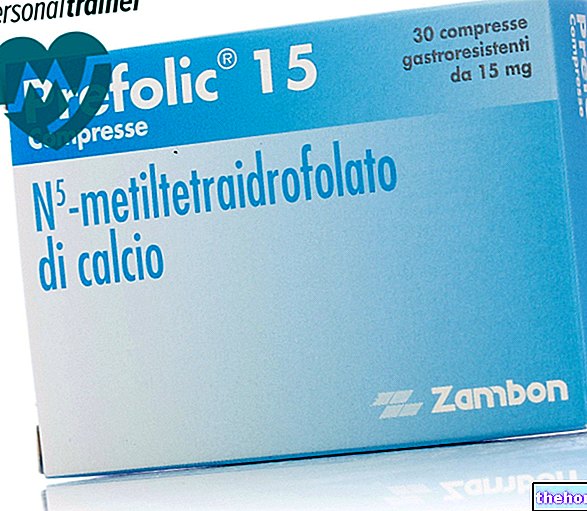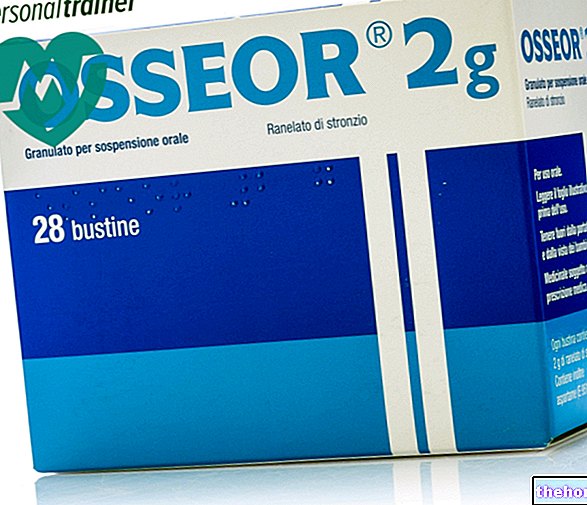Active ingredients: Folic acid (calcium N5-methyltetrahydrofolate)
15 mg gastro-resistant tablets
Why is Prefolic used? What is it for?
PHARMACOTHERAPEUTIC CATEGORY
Antianemic drugs
THERAPEUTIC INDICATIONS
In all forms of folate deficiency due to increased demand, reduced absorption, insufficient dietary intake.
In the antidotic therapy of excessive doses of folic acid antagonists and to combat the side effects induced by aminopterin and methotrexate.
Contraindications When Prefolic should not be used
Known hypersensitivity to the components.
For intravenous administration: concomitant treatment with ceftriaxone in neonates (≤28 days of age), even when using separate infusion lines. See sections "Interactions", "Undesirable effects" and "Dose, method and time of administration".
Precautions for use What you need to know before taking Prefolic
In the presence of pernicious anemia it is good practice to associate vitamin B12 with PREFOLIC to prevent neurological complications of the disease. If PREFOLIC is administered as a slow drip solution, prolonged exposure to oxygen in the air and the simultaneous administration of bicarbonates should be avoided.
In epileptic subjects, anticonvulsant drugs can cause a lowering of folatemia; the administration of PREFOLIC, while counterbalancing this effect, can increase the frequency of accesses.
Interactions Which drugs or foods can modify the effect of Prefolic
For intravenous administration: as with other calcium-containing solutions, concomitant treatment with ceftriaxone is contraindicated in neonates (≤28 days of age), even when using separate infusion lines (fatal risk of ceftriaxone calcium salt precipitation in the stream blood of the newborn, see section "Undesirable effects").
In patients over 28 days of age (including adults) ceftriaxone should not be administered concomitantly with intravenous solutions containing calcium including Prefolic through the same infusion line (e.g. via Y-connector).
If the same line is used for sequential administration, the line should be flushed with a compatible liquid between infusions.
Warnings It is important to know that:
Effects on ability to drive and use machines
It does not affect the ability to drive and use machines.
Dosage and method of use How to use Prefolic: Dosage
If intravenous administration is used, it is recommended to inject slowly.
After oral administration of PREFOLIC a blood peak is obtained at 2-3 hours which then decays slowly over time.
The average dosage of PREFOLIC for both oral and parenteral intramuscular or intravenous routes can be indicated in 15 mg per day or every other day according to medical prescription.
Treatment with PREFOLIC must be prolonged until complete remission of folic deficiency symptoms and reconstitution of the endogenous heritage. In exceptional cases or in the use of PREFOLIC for the antidotism of antipholic cytotoxic drugs (for example in the case of administration of high dose methotrexate), the posology may involve the use of higher doses, administered at intervals of a few hours: 15 mg orally every 6-8 hours or 50-100 mg intravenously every 3-8 hours for a few days according to the "rescue" parameters.
The tablets are gastro-resistant, ie they release the active principle in the proximal intestine; they should not be chewed, but should be swallowed whole, preferably in the morning.
Calcium salts can form complexes with many drugs and this can lead to the formation of precipitates. Physical incompatibility has been reported with ceftriaxone (see sections "Contraindications", "Interactions" and "Undesirable effects").
Overdose What to do if you have taken too much Prefolic
Clinical cases of overdose are not known so far.
Side Effects What are the side effects of Prefolic
With the use of the product, manifestations of hypersensitivity are possible (fever, urticaria, arterial hypotension, tachycardia, bronchospasm, anaphylactic shock). some fatal cases, in preterm and full-term infants (aged <28 days) who had been treated with intravenous ceftriaxone and calcium. The presence of ceftriaxone-calcium salt precipitation was detected post mortem in the lungs and kidneys. The high risk of precipitation in neonates is a consequence of their low blood volume and the longer half-life of ceftriaxone compared to adults (see sections "Contraindications" and "Interactions").
Cases of renal precipitation have been reported, mainly in children over 3 years of age treated with high daily doses (e.g. ≥ 80 mg / kg / day) or with total doses greater than 10 grams and who had other risk factors (e.g. . fluid restriction, bedridden patients). The risk of precipitate formation increases in immobilized or dehydrated patients. This event can be symptomatic or asymptomatic, can cause renal failure and anuria, and is reversible upon discontinuation of administration.
Precipitation of calcium ceftriaxone salt in the gallbladder has been observed, mainly in patients treated with doses above the recommended standard dose. In children, prospective studies have shown a variable incidence of precipitation with intravenous administration; in some studies the incidence was greater than 30%. This incidence appears to be lower with slow infusions (20-30 minutes). This effect is generally asymptomatic, but in rare cases the precipitations have been accompanied by clinical symptoms, such as pain, nausea and vomiting. In these cases symptomatic treatment is recommended. Precipitation is generally reversible upon discontinuation of administration.
If undesirable effects other than those described above occur, it is advisable to report them to the doctor.
Expiry and Retention
See expiry date indicated on the package.
The expiry date indicated refers to the product in intact packaging, correctly stored.
Warning: do not use the medicine after the expiry date indicated on the package.
Protect from light and store the tablets below 30 ° C.
QUALITATIVE AND QUANTITATIVE COMPOSITION
A 15 mg gastro-resistant tablet contains: N5-methyltetrahydrofolate calcium pentahydrate 19.18 mg equal to 15 mg acid. Excipients: corn starch, lactose, magnesium stearate, polyethylene glycol 6000, polymethacrylates, polysorbate 80, simethicone, sodium hydroxide, talc.
One vial of 15 mg powder contains: N5-methyltetrahydrofolate calcium pentahydrate 19.18 mg equivalent to 15 mg acid. Excipients: citric acid, glutathione, mannite, methyl p-hydroxybenzoate, sodium hydroxide.
One ampoule of solvent contains: water for injections.
One vial of 50 mg powder contains: N5-methyltetrahydrofolate calcium pentahydrate 63.93 mg equal to 50 mg acid. Excipients: citric acid, glutathione, mannite, methyl p-hydroxybenzoate, sodium hydroxide.
One ampoule of solvent contains: water for injections.
PHARMACEUTICAL FORM
30 gastro-resistant tablets of 15 mg
5 vials of 15 mg powder + 5 vials of 3 ml solvent
6 vials of 50 mg powder + 6 vials of 3 ml solvent
Source Package Leaflet: AIFA (Italian Medicines Agency). Content published in January 2016. The information present may not be up-to-date.
To have access to the most up-to-date version, it is advisable to access the AIFA (Italian Medicines Agency) website. Disclaimer and useful information.
01.0 NAME OF THE MEDICINAL PRODUCT
PREFOLIC
02.0 QUALITATIVE AND QUANTITATIVE COMPOSITION
• PREFOLIC 15 Tablets
One gastro-resistant tablet contains:
Active principle:
Calcium N5-methyltetrahydrofolate pentahydrate 19.18 mg equal to 15 mg acid.
• PREFOLIC 15 mg / 3 ml powder and solvent for solution for injection
One vial of powder contains:
Active principle:
Calcium N5-methyltetrahydrofolate pentahydrate 19.18 mg equal to 15 mg acid.
• PREFOLIC 50 mg / 3 ml powder and solvent for solution for injection
One vial of powder contains:
Active principle:
Calcium N5-methyltetrahydrofolate pentahydrate 63.93 mg equal to acid 50 mg.
03.0 PHARMACEUTICAL FORM
Gastro-resistant tablets.
Vials of powder + vials of solvent.
04.0 CLINICAL INFORMATION
04.1 Therapeutic indications
In all forms of folate deficiency due to increased demand, reduced absorption, insufficient dietary intake.
In the antidotic therapy of excessive doses of folic acid antagonists and to combat the side effects induced by aminopterin and methotrexate.
04.2 Posology and method of administration
After oral administration of PREFOLIC a blood peak is obtained at 2-3 hours which then decays slowly over time.
The average posology of PREFOLIC for both oral and parenteral intramuscular or intravenous routes can be indicated in 15 mg per day or every other day according to medical prescription.
Treatment with PREFOLIC must be prolonged until complete remission of folic deficiency symptoms and reconstitution of the endogenous heritage.In exceptional cases or in the use of PREFOLIC for the antidotism of antipholic cytotoxic drugs (for example in the case of administration of high dose methotrexate), the posology may involve the use of higher doses, administered at intervals of a few hours: 15 mg orally every 6-8 hours or 50-100 mg intravenously every 3-8 hours for a few days according to the "rescue" parameters.
04.3 Contraindications
Known hypersensitivity to the components.
For intravenous administrations: concomitant treatment with ceftriaxone in neonates (≤28 days of age), even when using separate infusion lines. See sections 4.5, 4.8 and 6.2.
04.4 Special warnings and appropriate precautions for use
If intravenous administration is used, it is recommended to give the injection slowly. In epileptic subjects, anticonvulsant drugs can cause a lowering of folatemia; the administration of PREFOLIC, while counterbalancing this effect, can increase the frequency of accesses.
The tablets are gastro-resistant, ie they release the active principle in the proximal intestine; they should not be chewed, but should be swallowed whole, preferably in the morning.
In the presence of pernicious anemia it is good practice to associate vitamin B12 with PREFOLIC to prevent neurological complications of the disease.
04.5 Interactions with other medicinal products and other forms of interaction
For intravenous administrations: as with other calcium-containing solutions, concomitant treatment with ceftriaxone is contraindicated in neonates (≤28 days of age), even when using separate infusion lines (fatal risk of ceftriaxone salt precipitation). calcium in the bloodstream of the newborn, see section 4.8).
In patients over 28 days of age (including adults) ceftriaxone should not be administered concomitantly with intravenous solutions containing calcium including Prefolic through the same infusion line (e.g. through a Y connector).
If the same line is used for sequential administration, the line should be flushed with a compatible liquid between infusions.
04.6 Pregnancy and lactation
This is a vitamin compound, a normal component of our organism, with no effects on the mother and fetus.
04.7 Effects on ability to drive and use machines
It does not affect the ability to drive and use machines.
04.8 Undesirable effects
With the use of the product are possible manifestations of hypersensitivity (fever, urticaria, arterial hypotension, tachycardia, bronchospasm, anaphylactic shock).
Precipitation of calcium-ceftriaxone salt (for intravenous administration)
Serious, and in some cases fatal, adverse reactions have been reported rarely in preterm and full-term infants (intravenously aged. The presence of calcium-ceftriaxone salt precipitation has been detected post mortem in the lungs and kidneys. L "The high risk of precipitation in neonates is a consequence of their low blood volume and the longer half-life of ceftriaxone compared to adults (see sections 4.3 and 4.5).
Cases of renal precipitation have been reported, mainly in children over 3 years of age treated with high daily doses (e.g. ≥ 80 mg / kg / day) or with total doses greater than 10 grams and who had other risk factors (e.g. . fluid restriction, bedridden patients). The risk of precipitate formation increases in immobilized or dehydrated patients. This event can be symptomatic or asymptomatic, can cause renal failure and anuria, and is reversible upon discontinuation of administration.
Precipitation of calcium ceftriaxone salt in the gallbladder has been observed, mainly in patients treated with doses above the recommended standard dose. In children, prospective studies have shown a variable incidence of precipitation with intravenous administration; in some studies the incidence was greater than 30%. This incidence appears to be lower with slow infusions (20-30 minutes). This effect is generally asymptomatic, but in rare cases the precipitations have been accompanied by clinical symptoms, such as pain, nausea and vomiting. In these cases symptomatic treatment is recommended. Precipitation is generally reversible upon discontinuation of administration.
04.9 Overdose
Clinical cases of overdose are not known so far.
05.0 PHARMACOLOGICAL PROPERTIES
05.1 Pharmacodynamic properties
Calcium N5-methyltetrahydrofolate (5-MTHF), a physiological molecule of a vitamin nature, is an active ingredient that intervenes in animal organisms in a series of important reactions, from a biochemical-metabolic point of view, aimed at carrying out the transfer of the mono-carbonaceous unit Among these reactions the following should be mentioned in particular:
to. the synthesis of purines and thymidylate, an essential step for the biosynthesis of nucleic acids;
b. the ex novo synthesis of labile methyls starting from serine, glycine, histidine, formate;
c. the synthesis of methionine starting from homocysteine, a reaction that requires the presence of vitamin B12 as a cofactor and therefore represents the point of interaction between folate and cobalamin.
05.2 Pharmacokinetic properties
Due to its characteristics as a physiological molecule, 5-MTHF is used by the organism as such, without undergoing further biotransformation processes. It constitutes the physiological form of transport of folic acid in the plasma, where it represents almost all of the circulating folates. It is readily absorbed from the digestive tract and, therefore, is distributed to all tissues including the CNS; it is in fact picked up by the chorioid plexuses in the cerebrospinal fluid where its concentration is equal to three times that of the blood.
The t½ of intravenous 5-MTHF is approximately 2 hours, orally approximately 2-3 hours. It is eliminated by the kidney and intestine.
05.3 Preclinical safety data
06.0 PHARMACEUTICAL INFORMATION
06.1 Excipients
• PREFOLIC 15 Tablets
Corn starch, lactose, magnesium stearate, polyethylene glycol 6000, polymethacrylates, polysorbate 80, simethicone, sodium hydroxide, talc.
• PREFOLIC 15 mg / 3 ml powder and solvent for solution for injection
Citric acid, glutathione, mannite, methyl p-hydroxybenzoate, sodium hydroxide. One ampoule of solvent contains: water for injections.
• PREFOLIC 50 mg / 3 ml powder and solvent for solution for injection
Citric acid, glutathione, mannite, methyl p-hydroxybenzoate, sodium hydroxide. One ampoule of solvent contains: water for injections.
06.2 Incompatibility
It should not be added to solutions containing bicarbonate.
Calcium salts can form complexes with many drugs and this can lead to the formation of precipitates. Physical incompatibility has been reported with ceftriaxone (see sections 4.3, 4.5 and 4.8).
06.3 Period of validity
• PREFOLIC 15 Tablets: 36 months
• PREFOLIC 15 mg / 3 ml and PREFOLIC 50 mg / 3 ml, powder and solvent for solution for injection: 30 months
The reconstituted product is stable for 10 hours.
06.4 Special precautions for storage
Protect from light and store the tablets below 30 ° C.
06.5 Nature of the immediate packaging and contents of the package
- Box containing 30 tablets of 15 mg in blisters (aluminum-polythene)
- Carton containing 5 hermetically sealed dark glass vials (rubber stopper and aluminum metal cap) of 15 mg + 5 glass vials containing 3 ml of solvent
- Carton containing 6 hermetically sealed dark glass vials (rubber stopper and aluminum metal cap) of 50 mg + 6 glass vials containing 3 ml of solvent
06.6 Instructions for use and handling
How to open the solvent vial:
- exert pressure with the thumb placed over the colored point.
07.0 MARKETING AUTHORIZATION HOLDER
ZAMBON ITALIA s.r.l. - Via Lillo del Duca, 10 - 20091 Bresso (MI)
08.0 MARKETING AUTHORIZATION NUMBER
- 30 tablets of 15 mg - A.I.C .: n. 024703124
- 5 vials of 15 mg powder + 5 vials of 3 ml solvent - A.I.C .: n. 024703098
- 6 vials of 50 mg powder + 6 vials of 3 ml solvent - A.I.C .: n. 024703112
09.0 DATE OF FIRST AUTHORIZATION OR RENEWAL OF THE AUTHORIZATION
- 30 tablets of 15 mg: 20.07.1989
- 5 vials of 15 mg powder + 5 vials of 3 ml solvent: 30.04.1982
- 6 vials of 50 mg powder + 6 vials of 3 ml solvent: 21.02.1985
Authorization renewal: 01.06.2010
10.0 DATE OF REVISION OF THE TEXT
January 14, 2015




























